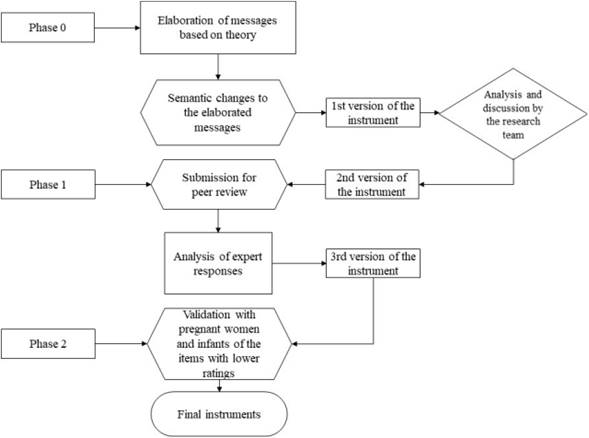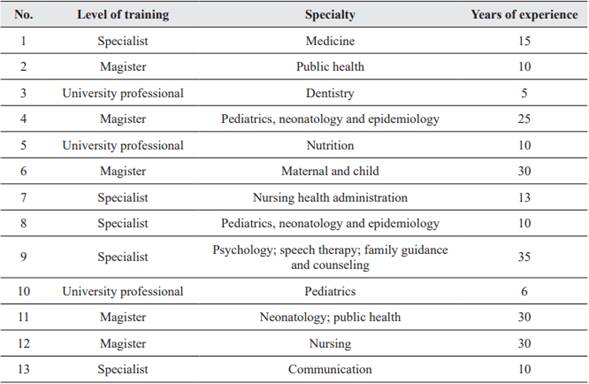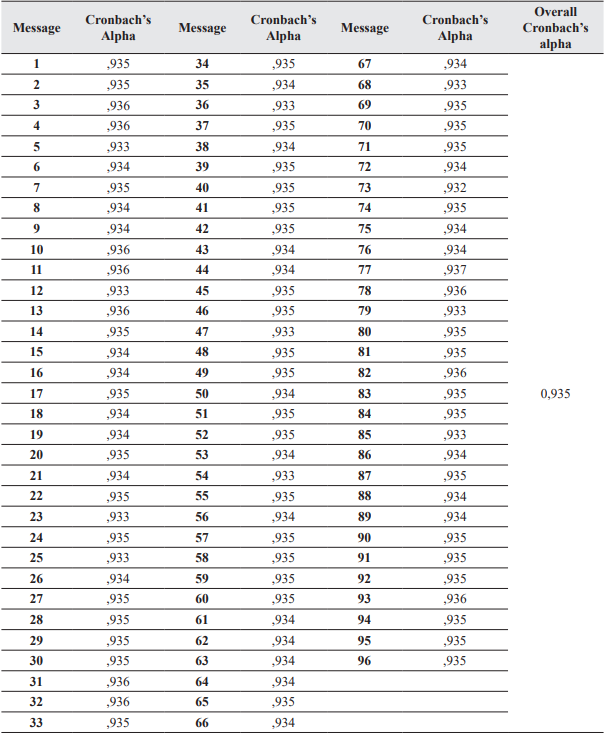Introduction
The World Health Organization and the Decennial Breastfeeding Plan 2010-2020 recommend breastfeeding at the first postpartum hour when the newborn receives its first colostrum milk, which has vital contents of immunoglobulins and antibodies and also stimulates breast milk production. Moreover, they insist that babies should exclusively be breastfed for their first 6 months of life and that they should receive complementary food up to 2 years of age to assure their adequate growth and development and help prevent infant mortality 1,2.
In Colombia, although the Decennial Breastfeeding Plan established actions to prioritize effective protection and support of breastfeeding, besides implementing strategies for its promotion, there are low indices and premature termination of breastfeeding, which affects the health status of children.
Between 2005 and 2010, exclusive breastfeeding descended from 47% to 45% and the total duration remained in 15 months, while for 2019 it was only 36%. These figures justify the need to strength activities in this area, such as breastfeeding training and coaching with all health staff and community agents as well as promotion of adequate practices in baby feeding along with information, education and communication strategies to contribute to national goals and to reach an exclusive breastfeeding rate of 42% by 2023. 3,4.
WHO and UNICEF proposed to improve early initiation of breastfeeding in at least 70% of Colombia in 2015; an average of 72,6% mothers of children under 3 years of age started breastfeeding in within an hour after birth, which exceeded the established goal of the organizations. Regarding breastfeeding, nearly 1 out of every 3 children under 5 months (36.1%) were exclusively breastfed. 5.
WHO and the consensus from different skilled groups concluded that exclusive breastfeeding during the first 6 months of age have benefits widely documented that benefited different aspects of the child and the mother, e.g., health, education, economy and social interaction. This indicator is part of the global goals in nutrition of WHO 2025 and states that during the decennial period from 2015 to 2015, 50% or children under six months of age were exclusively breastfed 5.
In 2015, 21.049 cases of exclusive breastfeeding with an average of 2.5, in 2017, 3.858 cases with an average of 3 were identified in Caldas. This indicator of exclusive breastfeeding remained for 3 months between 2016 and 2018 6.
In relation with continuous exclusive breastfeeding indicator in the country, a decrease from 58.1% in 2010 to 52.2% in 2015 was observed. In continuous breastfeeding indicator up to two years a decrease was observed with less intensity, from 32.5% in 2010 to 31.6% in 2015 6.
The most commonly used strategies in the current historical period are those related with Information and Communication Technologies (ICT), especially with mobile telephones, which is one the most important devices around the world. It is a useful and indispensable tool for transmission and reception of information in different ways (short messages service -text messages-) in daily life, even though its technology is simple 7,8.
Therefore the interest to include mobile phones in medical applications and similar areas has increased. They are tools that can be used to improve health care by sending educational and motivational text messages, which contributes to decrease medical attention, hospitalizations and selfcare, and allows real-time support for a health condition and improves self-care 7-9.
Thus, the goal of this research is to design and validate a database of text messages to encourage breastfeeding.
Materials and methods
Study Type: quantitative research, instrument validation type.
The process was done in three phases (Figure 1):
Phase 0. the text messages database was done through literature review, international and national manuals review, and messages sent by a group of professionals who participated in a diploma course in breastfeeding taught by the departmental breastfeeding committee of Caldas. Some semantic changes took place to obtain a better understanding that matched the project objective and the current guides of breastfeeding in the decennial breastfeeding plan 2010-2020.
Phase 1: review or judgement by experts through the Delphi technique: for this phase the research team selected the experts to participate through a non-probabilistic sampling, considering characteristics such as experience years, academic level and disciplinary working areas (Table 1). In total 20 professionals were invited from Gynecology - Obstetrics, Pediatrics, General Medicine, Nutrition, Nursing, Psychology, Dentistry, and Communication fields, 13 of them reviewed the messages database and made their evaluation, recommendations, and adjustments according to a matrix, qualifying relevance, pertinence, use, clarity, and appearance. Each dimension was graded with an -x- in a scale from 1 to 4, 1 was the lowest score and 4 was the highest. At the end of the quantitative evaluation, each expert presented their qualitative concept in relation with change proposals. For the information analysis, the SPSS version 22 was used. The calculation of internal consistency was done through Cronbach Alfa, for each message and for the instrument. The range scale presented by Ruiz Bolivar was considered for the final evaluation 10:
Phase 2: from the consolidated matrix of text messages evaluation, 10 messages had the lowest score by experts and were submitted to validation through 4 focal groups (theorist sample), made up of women in their last trimester of pregnancy and in breastfeeding stage who participated in preparation courses for maternity and paternity in different Health institutions, in 3 municipalities of the Caldas Department. Each focal group was led by a moderator from the research group. The messages assessment took place in two moments: the first one was done from 1 to 4 on clarity, pertinence, and vocabulary aspects, 1 was the lowest score and 4 was the highest; the second moment consisted of an open discussion space where women informed their understanding of the message, how important it was and what words to change.

Source: compiled by authors.
Figure 1 Phases in the process of validation and adaptation of text messages.
Ethical considerations: the project was approved by the Bioethics Committee of Health Sciences of the Caldas University, with the consecutive CBCS-040. The research had the approval signature from experts and breast feeders. Moreover, the established parameters in the Helsinki Declaration 11 and Resolution 008430 of 1993 were fulfilled 12 and this is considered a non-risky research.
Results
Phase 0: Messages elaboration from theory
The text messages Final Database included 96 messages on the following topics: anatomy and physiology of breastfeeding, human milk properties, breastfeeding advantages, prenatal preparation for breastfeeding, techniques, collection, human milk storage and conservation. These items made up the first instrument version, or first database, then the researchers’ teachers made the first review of messages and through a consensus technique a discussion of some semantic changes was held to better understand the project and breastfeeding guides in the decennial breastfeeding plan 2010-2020. The second database version was established and sent to experts for review and judgement.
Phase 1: Review by experts’ judgement
As mentioned in the methodology, 13 Health Sciences experts with maternal-infant knowledge participated in the validation process of the text messages. They provided input about the instrument adaptation for the Colombian breastfeeding population. Table 1 shows the characteristics of work experience with an average of 17.6 working years, professional and/or academic experience, with a minimum of 5 years and a maximum of 35. Regarding education, 76% had postgraduate or master’s degrees, completed at the time of the study. Higher academic education, support areas of expertise manifested by experts, mainly in pediatrics, maternal-infant and neonatology areas.
The contents validity was determined by the agreement of the experts who evaluated 96 text messages in the instrument, through a scale to valuate pertinence, relevance, use, clarity, and appearance.
The analysis of internal consistency by Cronbach Alfa calculation was done through messages, and for all the instrument (Table 2). Notice how all values are over 0.93, which means a “very high” internal consistency, according to the criteria established by Ruiz Bolivar, allowing the maintenance of all text messages to be included in the instrument final version.
Phase 2: Validation with pregnant and breastfeeding women
Even though Alfa Cronbach for all messages was considered “very high”, researchers selected the 10 messages with the lowest scores to be validated with women in their last trimester of pregnancy and in breastfeeding stage.
In total, four focal groups were used, with the participation of 34 women who signed an informed consent; their duration oscillated between 45 and 60 minutes, in which the researcher read the text messages out loud with the support of an observation guide and follow up their capacity to interpret them.
In the discussion process, no major problems were found with answering questions. The difficulty of mothers to interpret some technical and scientific terms used in some messages, such as hypophysis, prolactin, and aureole was noticeable. In general, mothers concluded that messages were easy to understand. Therefore, the vocabulary of some messages was adapted.
Finally, messages were reviewed and valuated by researchers to warranty that the text messages database on breastfeeding were relevant and fine as well as respectful of the recommendations of experts, and the group of mothers, based on the objective of this article which is to design and validate a database of text messages to encourage breastfeeding.
Discussion
In this research the validation and adaptation of text messages was done as a strategy with ITCs to encourage breastfeeding, which, according to Mota et al., must be strengthened in mothers to consolidate the relation motherchild and improve the health of the baby 13.
Text messages were considered as the best strategy to encourage breastfeeding since it foster mother-child communication in a very effective way in an era of technology, according to the findings by Jenaro et al, who in 2016 concluded that text messages intervention is a promising strategy to encourage healthy habits 14.
Likewise, Ortiz et al identified that most pregnant women had access to ITCs, especially to cellphones, which became the most used and most appropriate technological tools to provide health care, as part of health service attention. 15.
Results of this research show that the use of text messages to encourage breastfeeding is a relevant alternative that can be used easily thanks to the availability and access to cellphones by mothers; besides, they are interested in obtaining information and guidance through this device, as stated by Ortiz et al 15.
In total, there were 96 text messages included in this research about necessary aspects for an adequate breastfeeding process, among them, anatomy and physiology of breastfeeding, properties of human milk, advantages of breastfeeding, prenatal preparation, breastfeeding techniques, collection and storage and conservation of human milk. Strengthening these elements is important to avoid high rates of abandonment of exclusive breastfeeding before six months, as expressed by Araque et al, and it has a negative impact on society and affects both mothers and the community, which makes it a public health priority 16.
These authors consider that it is important to use the ITCs to encourage, assess and improve the support and professional care during the initiation and maintenance of exclusive breastfeeding, mainly in the first puerperal days. They also consider that these technological tools give resources for health professionals to adequately coordinate health care, including prevention, promotion and follow up at different care levels. 16. Similar conclusions were found by Garcia et al who, in their research, identified how new technologies and social media help women to clear doubts of traditional health services, promote breastfeeding and create new areas to get in touch with mothers 17.
Cronbach Alfa was valuated in this research as “very high”, suggesting an adequate internal consistency of text messages. These results are similar to the ones presented by Reyes and Ibarra who validated a family support questionnaire for exclusive breastfeeding maintenance, with a “high” grade, with Cronbach Alfa of 0.77 18. Fernandez and Menendez found an internal consistency of 0.87 in the validation process of a questionnaire on knowledge and abilities in breastfeeding 19.
The results of the validation process with experts and the valuation given by pregnant women in comprehension tests support the importance of messages to promote breastfeeding, and coincide with Velez et al., 20 and Lira and Caballero 21 in their validation processes.
Conclusions
The validation process through expert consensus, with the delimitation of a clear methodology, is an ideal alternative for the development, organization, evaluation and adaptation of an instrument to encourage breastfeeding in pregnant women or in their breastfeeding period.
The participation of qualified experts in maternal -infant areas was fostered to obtain an objective messages evaluation, to identify opportunities of change and to improve and adapt the instrument in an optimal way with this population.
This research allowed to obtain information, elements and guidance to plan the recommendations that must be given to mothers and the community on breastfeeding and consider it as a methodology to work in educative health practices, supported by quantitative results shown through Cronbach Alfa, as well as to support the internal consistency of the instrument and comprehension tests for pregnant and breastfeeding mothers, maintaining total messages to encourage breastfeeding.
















